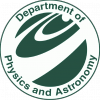User Tools
Sidebar
projectideas
PROJECTS
Projects: Projects, Project Ideas
Project Ideas
Neutrino Driven Wind
- By doing a literature search, determine three different types of neutrino spectra that are appropriate for neutrino driven wind conditions. Alter the reaction network to include neutrino interactions on free nucleons. Calculate an abundance pattern for a neutrino driven wind model with the three different types of spectra. Analyze the results and discuss what characteristics of the spectra lead to different outcomes.
Neutron Star Merger r-process
- Determine, using the literature, representative conditions for tidal ejection of material from neutron star mergers and for neutrino driven winds. Calculate, using the reaction network, abundance patterns for each and compare the results. Discuss why the patterns look different.
BBN:
- Quantify the sensitivities of the light elements to variations in the key reaction rates. Propagate uncertainties in nuclear reation rates via Monte Carlo to evaluate the uncertainties in the BBN predictions.
- Explore the consequences of new physics during BBN. This can include: adding neutrino species, modification of the gravitational constant, neutrino degeneracy and neutrino oscillations.
- For a more challenging calculation, consider the effect of dark matter decays that dissociate 4He.
- For each of these, what is the effect on the light elements?
- How can we use light element and cosmological (e.g., CMB) observations to constrain these scenarios?
Exploding a polytropic star
- Create a hydrostatic configuration for a polytropic star. Solutions can be derived from the Lane-Emden equation (Lane-Emden equation).
- Please look in the “Explode a Polytropic Star” folder in the Projects/Project Ideas folder in the Document Server for a python code that calculates the profile of a polytropic star.
- For an initial condition, increase the central pressure (and only the central point) by some factor of the hydrostatic value (just as in the Sedov Blast Wave).
- Evolve the star given this deposition of energy in the center of the star.
- Questions you can try to answer
- Find the factor needed to explode the star. Is this derivable analytically?
- How do trajectories differ when the factor is: half, equal, and twice the critical explosion value?
- Do all trajectories escape?
- How do things change with different polytropic indices?
- Assume an initial composition for all fluid elements.
- How does the composition in each trajectory evolve?
- What does the final composition of the whole “star” look like?
- How does the final composition of the escaped trajectories compare to the total?
Post-Processing nucleosynthesis
- Extract a Lagrangian profile from the blast wave simulation and use the network to calculate the nucleosynthesis.
Numerics of Blast Waves
- Explore how resolution, dimensionality and the nature of the grid affect a blast wave simulation.
Reaction Sensitivity studies
- Change reactions in the network and examine the impact on the abundances. We can easily do this for CCSN, TNSN, novae, XRB, maybe others.
Impact of Neutronization on supernova nucleosynthesis
- Vary the initial electron fraction and examine how CCSN nucleosynthesis changes.
hydro:
- Simulate the effects of a near-earth supernova explosion at 10 pc (the “kill radius”) and the resulting collision of the blast with solar wind. Will the supernova reach 1 AU? How does the answer depend on the supernova explosion energy? Distance? Interstellar density?
nuke network:
- Simulate the s-process under AGB conditions. Compare to solar system abundances and presolar grains. How does the result depend on initial composition? How good is the waiting point approximation?
projectideas.txt · Last modified: 2014/06/06 13:39 by cyburt
Except where otherwise noted, content on this wiki is licensed under the following license: CC Attribution-Share Alike 4.0 International




